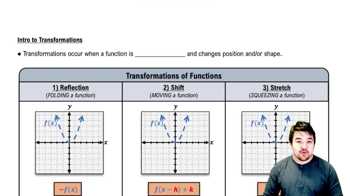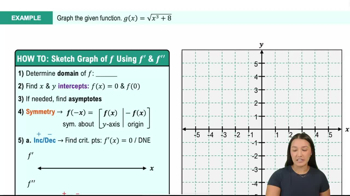Table of contents
- 0. Functions7h 52m
- Introduction to Functions16m
- Piecewise Functions10m
- Properties of Functions9m
- Common Functions1h 8m
- Transformations5m
- Combining Functions27m
- Exponent rules32m
- Exponential Functions28m
- Logarithmic Functions24m
- Properties of Logarithms34m
- Exponential & Logarithmic Equations35m
- Introduction to Trigonometric Functions38m
- Graphs of Trigonometric Functions44m
- Trigonometric Identities47m
- Inverse Trigonometric Functions48m
- 1. Limits and Continuity2h 2m
- 2. Intro to Derivatives1h 33m
- 3. Techniques of Differentiation3h 18m
- 4. Applications of Derivatives2h 38m
- 5. Graphical Applications of Derivatives6h 2m
- 6. Derivatives of Inverse, Exponential, & Logarithmic Functions2h 37m
- 7. Antiderivatives & Indefinite Integrals1h 26m
- 8. Definite Integrals4h 44m
- 9. Graphical Applications of Integrals2h 27m
- 10. Physics Applications of Integrals 2h 22m
5. Graphical Applications of Derivatives
Curve Sketching
Problem 35
Textbook Question
Use the guidelines of this section to make a complete graph of f.
f(x) = tan⁻¹ (x²/√3)
 Verified step by step guidance
Verified step by step guidance1
Identify the domain of the function f(x) = tan⁻¹(x²/√3). Since the arctangent function is defined for all real numbers, the domain of f(x) is all real numbers.
Determine the symmetry of the function. Since f(x) involves x², which is an even function, f(x) is also an even function. This means the graph is symmetric with respect to the y-axis.
Find the critical points by taking the derivative of f(x) with respect to x. Use the chain rule to differentiate: f'(x) = (1/(1 + (x²/√3)²)) * (2x/√3). Set f'(x) = 0 to find critical points.
Analyze the behavior of f(x) as x approaches positive and negative infinity. Since the arctangent function approaches π/2 as its argument goes to infinity and -π/2 as its argument goes to negative infinity, f(x) will have horizontal asymptotes at y = π/2 and y = -π/2.
Plot key points and asymptotes on the graph. Use the symmetry, critical points, and asymptotic behavior to sketch the complete graph of f(x).
 Verified video answer for a similar problem:
Verified video answer for a similar problem:This video solution was recommended by our tutors as helpful for the problem above
Video duration:
13mPlay a video:
Was this helpful?
Key Concepts
Here are the essential concepts you must grasp in order to answer the question correctly.
Inverse Functions
Inverse functions, such as the arctangent function (tan⁻¹), reverse the effect of their corresponding functions. For example, if y = tan(x), then x = tan⁻¹(y). Understanding how to manipulate and graph inverse functions is crucial for analyzing the behavior of f(x) = tan⁻¹(x²/√3).
Recommended video:

Inverse Cosine
Graphing Techniques
Graphing techniques involve plotting points, identifying asymptotes, and understanding the overall shape of a function. For f(x) = tan⁻¹(x²/√3), recognizing that the arctangent function has horizontal asymptotes at y = ±π/2 helps in sketching the graph accurately, especially as x approaches positive or negative infinity.
Recommended video:

Graphing The Derivative
Transformations of Functions
Transformations of functions include shifts, stretches, and reflections that alter the graph of a function. In f(x) = tan⁻¹(x²/√3), the x² term indicates a vertical stretch and affects the symmetry of the graph, while the division by √3 scales the output. Understanding these transformations is essential for accurately graphing the function.
Recommended video:

Intro to Transformations

 11:41m
11:41mWatch next
Master Summary of Curve Sketching with a bite sized video explanation from Callie
Start learning




